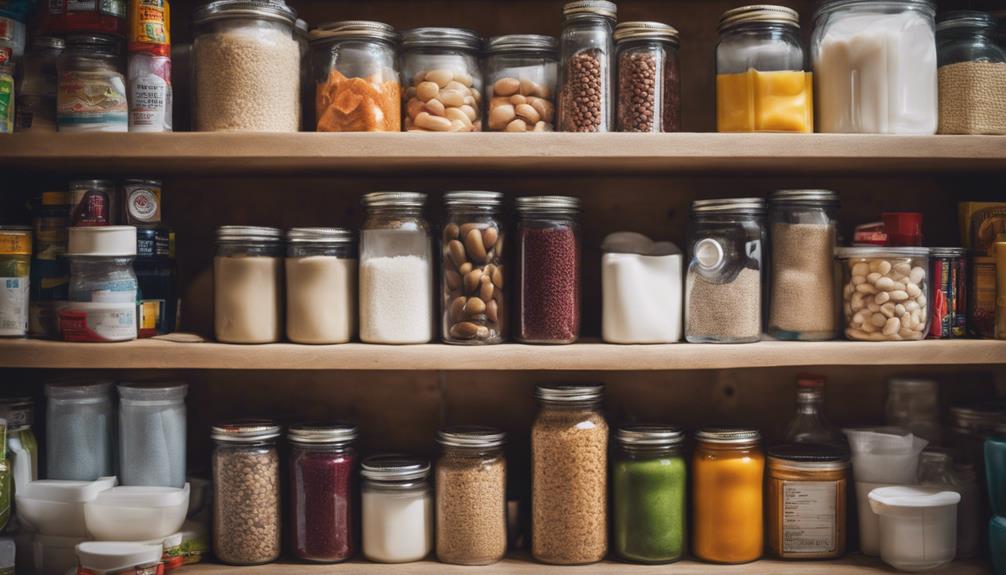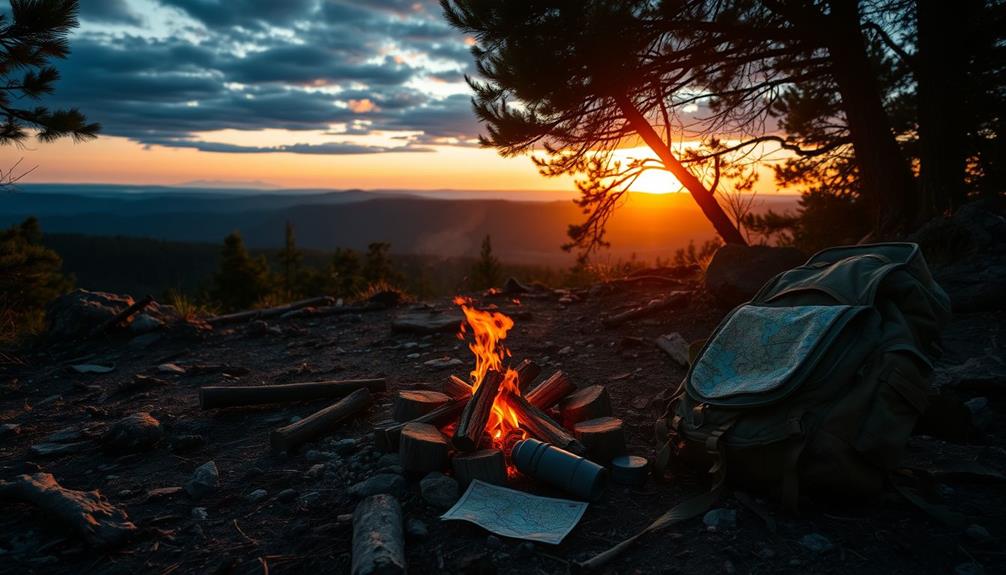Knowing how to start and manage a fire is a critical skill that could save your life in emergencies. Fire provides warmth, cooks food, and purifies water, all essential for survival. You'll need to gather dry tinder and kindling, create a proper fire structure, and use techniques like flint and steel or a bow drill to ignite it. Remember to practice fire safety, including keeping the area clear and managing the flames responsibly. Mastering these skills not only boosts your confidence but also guarantees you're prepared for unexpected situations. Stick around to discover more about effective fire-building techniques.
Key Takeaways
- Mastering fire starting techniques can provide warmth, cook food, and purify water in survival situations, significantly enhancing your chances of survival.
- Understanding proper fire structure and fuel selection ensures effective burning, maximizing heat output and minimizing smoke, which is crucial for signaling rescue.
- Knowing how to quickly and safely extinguish fires prevents unintentional wildfires, protecting both life and the environment.
- Familiarity with fire safety practices, including smoke alarms and emergency procedures, can save lives and reduce property damage during a fire emergency.
- Ethical fire use and awareness of environmental impacts promote responsible practices, ensuring that fire skills benefit both individuals and ecosystems.
Importance of Fire in Survival

When it comes to survival, fire is more than just a flickering flame; it's an essential lifeline. You rely on fire to boil water, making it safe to drink, which is vital for staying hydrated. Cooking food over a fire not only enhances its taste but also guarantees it's safe for consumption, keeping you nourished. Fire provides warmth, preventing hypothermia in cold conditions, and can even be used to cauterize wounds in emergency situations, helping you manage injuries effectively.
Beyond the basics, fire offers safety and protection. It can deter wild animals, giving you peace of mind, and serves as a signal for rescue when combined with smoke. In the dark, fire lights your path, making navigation easier and safer. Mastery of fire-starting techniques is crucial in adverse conditions, ensuring that you can create a flame when it matters most. On a psychological level, the presence of fire creates a sense of home and comfort, boosting your morale.
Essential Materials for Fire

When you're starting a fire, the right materials make all the difference. You'll want to gather effective tinder, like dry leaves or cotton balls soaked in petroleum jelly, to spark the flames. Once you've got that, choosing the right fuelwood guarantees your fire burns strong and lasts longer. Additionally, mastery of fire-building techniques can ensure that you create a sustainable and efficient fire, which is crucial for warmth and cooking in survival situations.
Types of Tinder
Tinder is the lifeblood of fire-starting, providing the essential spark needed to ignite larger fuels. When you're out in the wild, natural materials like birch bark, fatwood, and cedar bark serve you well. Birch bark, rich in resins, ignites even when damp, delivering a strong flame. Fatwood, sourced from resinous pine, burns hot and long, making it a reliable choice. Cedar bark is fibrous and can also light up when wet. Additionally, various types of tinder can be categorized by their burn duration and usability for effective fire-making.
If you prefer man-made options, char cloth and charred cotton catch even the smallest sparks. Cotton balls mixed with petroleum jelly extend your burn time considerably, which is vital in survival scenarios. Feathersticks, made from fine wood shavings, ignite quickly and effectively.
Don't overlook unconventional materials like steel wool, which ignites with a 9V battery, or dryer lint, which burns well. Even everyday items like toilet paper and paper from packaging can be effective. Remember, the key to a successful fire lies in your choice of tinder, so gather a variety to guarantee you're prepared for any situation.
Choosing Effective Fuel
Effective fuel is essential for maintaining a steady fire, and choosing the right materials can make all the difference in your success. When selecting fuel, focus on kindling and wood that ignite easily and sustain a robust fire. Here are three key factors to contemplate:
- Material Selection: Use dry twigs, pine needles, or shredded bark for kindling. Avoid damp materials that won't catch fire easily. For firewood, opt for seasoned hardwoods like oak or maple, as they burn longer and hotter. Using effective firestarters like Wolf & Grizzly can significantly enhance your ability to ignite this kindling quickly.
- Size and Arrangement: Start with small, thin kindling arranged in a crisscross pattern to allow airflow. As the fire grows, gradually add larger, split logs stacked to provide ventilation.
- Sustainability: Choose wood from sustainable sources, such as dead trees or fallen branches. This guarantees you're not harming living ecosystems while also promoting a healthier fire.
Effective Fire Starting Techniques

When it comes to starting a fire, knowing the basics is essential, but mastering advanced techniques can make all the difference. You'll want to take into account your environment, as it can greatly affect your fire's success. Fire requires three elements—heat, fuel, and oxygen—to ignite properly, making it crucial to understand these components when attempting to start a flame. Let's explore some effective methods that will help you ignite a flame in any situation.
Basic Fire Starting Methods
Starting a fire can be a critical skill in survival situations, and knowing various methods can make all the difference. Here are three basic fire starting techniques you can master:
- Hand Drill: Cut a V-shaped notch in your fireboard and create a small depression nearby. With a 2-foot spindle, roll it between your palms to generate friction. Maintain pressure and speed until an ember forms. Tap the board to deposit the ember onto a tinder bundle and gently blow to ignite. This technique is best suited for dry climates to ensure optimal performance.
- Flint and Steel: Grab a piece of flint and a carbon-steel striker. Strike the steel against the flint to produce sparks. Direct these sparks onto char cloth or tinder. When it glows, blow gently to coax it into a flame.
- Bow Drill: Use a bow, spindle, fireboard, and socket. Cut a notch in the fireboard, then saw the spindle back and forth with the bow to create friction. Apply pressure with the socket, drop the ember into a tinder nest, and blow to ignite.
Master these methods, and you'll be well on your way to building a fire when it counts!
Advanced Ignition Techniques
In survival situations, mastering advanced ignition techniques can give you a significant edge. One effective method is the bow drill, which uses a bow to rotate a spindle against a fireboard. The right combination of materials is essential; guarantee your spindle and fireboard complement each other to generate enough friction. Maintain consistent pressure and speed, focusing on the notch cut into the fireboard for ideal coal production. Additionally, ensuring you have an adequate supply of dry tinder and kindling will enhance your chances of successful ignition.
Another innovative technique is using a magnifying glass. On sunny days, this tool can focus sunlight onto your tinder, especially when paired with char cloth. Hold the lens close and adjust it until you find the perfect focal point, but remember, patience is key here.
You might also want to take into account a ferro rod. This durable tool produces hot sparks, even in wet conditions, and can ignite both pre-made tinder and natural materials. With practice, you'll master the correct angle and technique for consistent sparks.
Lastly, the fire piston offers a unique approach by using rapid air compression to create a hot ember. It's simple and effective, perfect for moist environments, but be aware that it might be pricier than other methods.
Environmental Considerations
Effective fire starting hinges on several essential environmental considerations. To guarantee your fire is efficient and safe, pay attention to your surroundings and preparation.
- Fire Site Preparation:
- Clear the area of debris, snow, and leaf litter to prevent accidental fires.
- Guarantee good airflow around your fire pit for a steady burn.
- Choose a location away from flammable materials and overhanging branches.
- Material Selection:
- Use dry tinder, kindling, and fuel wood to guarantee quick ignition.
- Select kindling that's easily combustible and free of moisture.
- Opt for hardwoods for better friction properties if using friction methods.
- Proper kindling selection is essential as it significantly impacts the success of your fire starting efforts.
- Fire Structure and Arrangement:
- Arrange tinder at the center, surrounded by kindling in a teepee or log cabin structure.
- Build a top-down fire, placing larger logs at the bottom and kindling at the top.
- Guarantee your structure allows for adequate ventilation.
Designing a Functional Fire

Designing a functional fire involves a meticulous approach to safety and efficiency, guaranteeing that every aspect of a building's design minimizes fire risks while providing effective response strategies. Start by identifying potential fire hazards early in the design phase. Use non-combustible materials to reduce the risk of ignition, and make certain your design complies with fire safety provisions of building codes.
Incorporate automatic fire detection systems that alert occupants and emergency services at the first sign of danger. Clear communication among stakeholders is crucial, so verify that alarm systems and emergency exit signs are visible and well-maintained. Regular testing and maintenance of these systems is essential to ensure their reliability during emergencies to uphold this principle.
Design egress pathways carefully, allowing occupants adequate time and opportunity to escape safely. Consider human behavior in your design, providing refuge areas if necessary. Structural elements should withstand fire long enough for evacuation and firefighter intervention.
Safety Practices Around Fire

Understanding fire safety practices can considerably reduce your risk of injury or loss in the event of a fire. It’s crucial to be proactive, as many home fires can be prevented with simple measures. Here are three key practices you should follow: First, ensure that all smoke alarms in your home are in working order by testing them regularly and replacing the batteries as needed. Secondly, create and regularly practice a fire escape plan with your family, taking note of all possible exits and ensuring that they are unobstructed. Finally, familiarize yourself with common fire safety tips, such as keeping flammable items away from heat sources and never leaving cooking unattended. These practices can make a significant difference in protecting your home and loved ones in the event of a fire.
- Install Working Smoke Alarms: Verify you have a working smoke alarm in every sleeping area and on every level of your home. Check the batteries regularly, as nearly 82% of fire incidents resulting in deaths had no working smoke alarm.
- Conduct Fire Safety Audits: Take the time to review your home's fire escape plan and confirm it's clear of obstacles. This is especially important if you live with vulnerable individuals. Recent statistics show that 81% of home fire safety checks target those with vulnerabilities, reflecting the importance of HFSCs for safety.
- Practice Safe Cooking Habits: Since cooking accounts for nearly 48% of residential fires, avoid distractions and keep flammable items away from your cooking area. Always stay in the kitchen when frying, grilling, or boiling food.
Ethical Considerations for Fire Use

When you think about fire use, it's vital to take into account its environmental impact and how you manage it responsibly. You're not just dealing with flames; you're also influencing the ecosystem around you. By practicing ethical fire management, you help protect both the environment and your community's well-being. This approach aligns with the principle of Putting Communities First, ensuring that the needs of the public and the environment are prioritized in fire-related decisions.
Environmental Impact Awareness
Fire, while a powerful tool for various purposes, carries significant ethical considerations regarding its environmental impact. When you use fire, it's essential to understand how it can harm the environment. Here are three key impacts to keep in mind:
- Air Quality: Fires release harmful chemicals and greenhouse gases, contributing to air pollution. This not only affects your health but also that of nearby communities and ecosystems. Additionally, smoke limits photosynthesis by forming a layer over plants, further exacerbating air quality issues.
- Water Resources: Fire can contaminate local water bodies through runoff, leading to toxic elements like heavy metals and harmful algal blooms. This pollution can impact wildlife and human health for years.
- Ecosystem Disruption: Fires can alter habitats, reducing vegetation and increasing erosion. This loss can threaten wildlife by destroying their food sources and homes, impacting entire ecosystems.
Being aware of these impacts encourages responsible fire use. You should consider alternatives and minimize fire's footprint whenever possible. Understanding these ethical considerations helps you make informed decisions that protect both yourself and the environment.
Responsible Fire Management
Responsible fire management requires a proactive approach to secure safety and protect lives. You have a moral obligation to guarantee a safe work environment, which means providing adequate fire protection systems and conducting regular training. By eliminating fire hazards and maintaining equipment, you can avoid harm and guarantee all employees and customers have equal access to safety measures.
It's essential to comply with fire safety laws while balancing practical measures with an ethical framework that prioritizes human well-being. Create a fire safety policy that assigns clear roles and responsibilities, and conduct regular fire risk assessments to identify potential threats. Regular audits ensure ongoing compliance and safety improvements.
Training is key—guarantee employees know how to use fire safety equipment and understand their role in maintaining a safe environment. Regular fire drills foster a culture where safety is everyone's responsibility.
In case of an incident, have a clear response strategy that prioritizes evacuation over property preservation. Develop an emergency plan and communicate it effectively. After any fire incident, conduct a thorough investigation to prevent future occurrences and adjust protocols based on your findings. By embracing these practices, you'll play a vital role in responsible fire management.
Practicing Fire Skills

Practicing fire skills is vital for everyone, as it equips you with the knowledge and techniques to handle emergencies effectively. To become proficient, focus on these key areas:
- Understanding Fire Behavior: Learn about the fire triangle—heat, fuel, and oxygen—to grasp how fires ignite and spread. Familiarize yourself with different classes of fire (A, B, C, D, and K) and the right extinguishing methods for each. Understanding that fire can double in size in just 2-3 minutes highlights the importance of quick action.
- Mastering Fire Extinguisher Techniques: Practice the PASS technique (Pull, Aim, Squeeze, Sweep) to operate extinguishers properly. It's important to inspect fire extinguishers monthly for any damage and confirm they're at the right pressure level.
- Developing Practical Fire Fighting Skills: Engage in regular drills and simulations to mimic real-life scenarios. This includes training in ground ladder handling, deploying hoses, and practicing search and rescue techniques in smoke-filled settings.
Mental Preparation for Fire Starting

While starting a fire can seem straightforward, mental preparation plays an essential role in ensuring success, especially in challenging conditions. A clear mind helps you focus, which is vital when stress levels rise. You'll need patience, as establishing a fire takes time, particularly when the elements are against you. Cultivating a grounded attitude allows you to maintain calmness and concentrate on the task at hand.
Anticipating potential challenges—like wet wood or strong winds—prepares you mentally for what lies ahead. Familiarizing yourself with safety guidelines keeps you aware of how to create a safe fire-starting environment. Mentally rehearsing each step can enhance your readiness, ensuring you know exactly what to do. Understanding the importance of fire in survival emphasizes the need for effective fire-starting skills during emergencies.
Managing stress effectively is critical. Use relaxation techniques to maintain focus, and practice making clear decisions under pressure. As you gain experience, your confidence will grow, reducing the stress associated with fire starting.
Common Fire Pit Designs

When designing a fire pit, it's essential to take into account both functionality and aesthetics to create a space that invites warmth and social interaction. There are several budget-friendly designs you can consider for your fire pit, each offering unique charm and practicality.
Here are three common options:
- Retaining Wall Blocks: Stack these blocks with sand and pavers for a sturdy, mortar-free structure. The design is simple yet effective, allowing for easy assembly.
- Salvaged Bricks: Repurpose old bricks for an in-ground fire pit, adding an extra ring for visual interest. This eco-friendly option gives your space a rustic feel.
- Concrete Tree Rings: These can create a distinctive look. Just remember to line the inside with fire brick and fire clay mortar to guarantee safety. Additionally, using repurposed materials not only reduces costs but also enhances the unique character of your fire pit.
Whatever design you choose, make certain it reflects your personal taste while being safe and functional for gatherings around the fire.
Real-Life Applications of Fire Skills

Fire skills play an essential role in various real-life situations, from workplace safety to emergency preparedness. In the workplace, effective fire safety training can markedly reduce property damage, which costs U.S. businesses an estimated $328 billion annually. By learning to handle flammable materials safely, you help protect your company's assets and improve response times during emergencies. Additionally, engaging in VR fire training enables employees to practice realistic fire scenarios in a controlled environment.
Moreover, fire safety training guarantees your safety and that of your colleagues. With the right knowledge, you can swiftly put out approximately 95% of fires using the appropriate fire extinguisher. You'll understand common fire causes and evacuation procedures, fostering a safer work environment.
In emergency scenarios, having fire skills boosts your confidence and efficiency. You'll learn how to utilize fire alarms, extinguishers, and navigate confined spaces safely. This training also emphasizes the importance of collecting essential belongings during an evacuation without wasting time.
Frequently Asked Questions
What Type of Wood Burns the Longest for Survival Fires?
For survival fires, you'll want to choose hardwoods like oak, beech, or ash, as they burn longer due to their dense structure. These woods produce high-temperature fires, making them ideal for consistent heat. If you opt for softwoods, go for red fir or lodgepole pine, which also provide good burn times when seasoned properly. Remember, well-seasoned wood with low moisture content is essential for an efficient and effective fire.
Can I Use Fire for Warmth in a Rainstorm?
You shouldn't use fire for warmth during a rainstorm. The risk of sparks igniting nearby flammable materials increases considerably, even with light rain. Instead, opt for safe indoor heating options like central heating or space heaters. Always keep heating appliances in good condition and away from anything flammable. If a thunderstorm approaches, seek shelter and stay informed about the weather to guarantee your safety.
How Do I Extinguish a Fire Safely and Completely?
To extinguish a fire safely and completely, first assess the fire's size. If it's manageable, grab the correct fire extinguisher and pull the safety pin. Aim at the fire's base, squeeze the handle, and sweep side to side. For larger fires, evacuate immediately and call emergency services. Always keep an eye on escape routes, and remember to stay low if smoke is present. Regular training will help you act quickly and confidently.
Is It Safe to Cook Food Directly Over an Open Flame?
Cooking directly over an open flame can be a fiery fiasco! It's not the safest method, as food can burn quickly and cook unevenly. Flare-ups from fatty foods can create chaos, leading to charred meals. Instead, try using a grill or cooking rack to regulate heat. Keep your distance from the flames, and avoid drippy foods. Always monitor your cooking space for safety, ensuring you've got a fire extinguisher nearby just in case!
What Should I Do if My Fire Won't Start?
If your fire won't start, check your materials first. Confirm your tinder is dry and flammable. If it's too damp, switch to different tinder, like dry grass or leaves. Make sure your kindling is small and dry as well. Next, review your technique; maybe you're not generating enough heat. Adjust your methods, like using a bow drill instead of a hand drill, and ensure oxygen flows freely. Don't lose patience; persistence is key!
Conclusion
Mastering fire skills isn't just a fun outdoor activity; it's an essential survival skill. Did you know that nearly 80% of wildfires are caused by human activity? This statistic highlights the importance of understanding fire safety and techniques. By honing your fire-starting abilities and practicing safety measures, you not only prepare yourself for emergencies but also contribute to preventing wildfires. So, get out there, practice, and be ready to handle fire responsibly—it could save your life!










